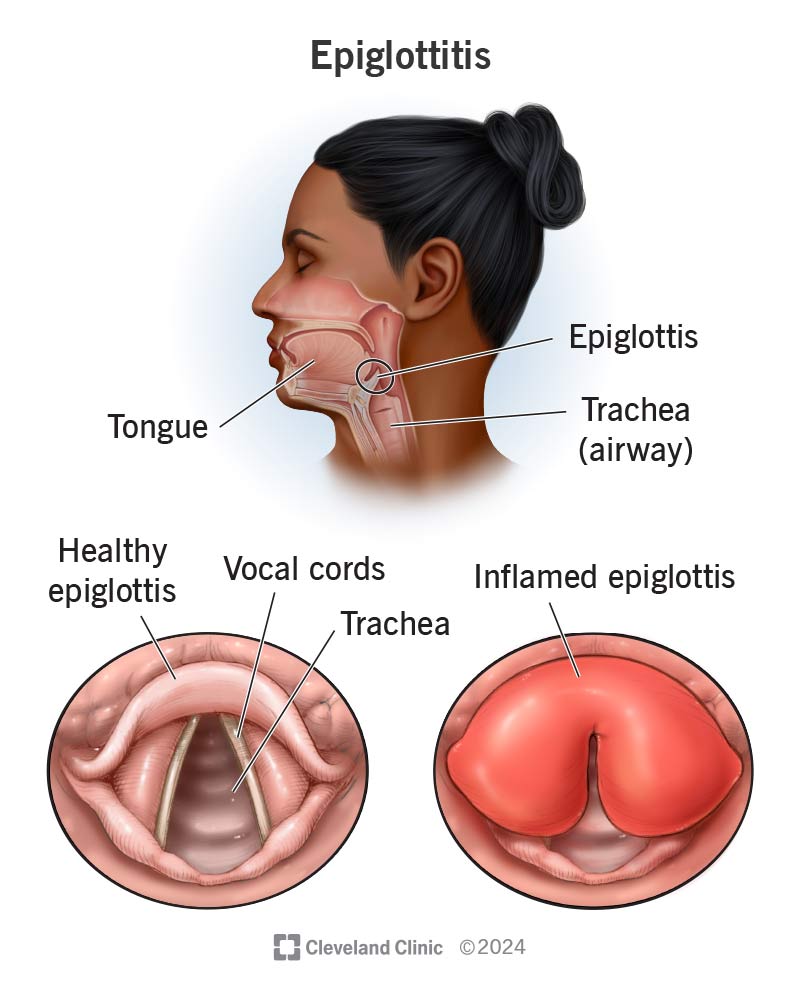Epiglottitis is inflammation and swelling of your epiglottis. The most common cause is bacterial infection. Epiglottitis symptoms include pain when swallowing, severe sore throat and difficulty breathing. Although most people recover fully after treatment, it’s a medical emergency that requires prompt medical care in the emergency room.
Advertisement
Cleveland Clinic is a non-profit academic medical center. Advertising on our site helps support our mission. We do not endorse non-Cleveland Clinic products or services. Policy

Epiglottitis (pronounced “eh-pih-glah-tai-tis”) is inflammation and swelling of your epiglottis. Your epiglottis is a thin flap of cartilage near the base of your tongue. It keeps food and liquids from going down your windpipe (trachea) when you swallow.
Advertisement
Cleveland Clinic is a non-profit academic medical center. Advertising on our site helps support our mission. We do not endorse non-Cleveland Clinic products or services. Policy
You may also hear the term “acute epiglottitis.” This refers to the very sudden and intense onset of symptoms, including difficulty breathing and swallowing. Without prompt treatment, the swelling can block your airway and even be fatal.
It’s essential to get to the emergency room (ER) immediately if you or a loved one is experiencing symptoms of epiglottitis. Epiglottitis is a medical emergency that you should never try to manage at home.
Epiglottitis is an uncommon condition that affects both children and adults.
Before the widespread use of Haemophilus influenzae (Hib) vaccinations in 1985, epiglottitis mainly affected children between the ages of 3 and 5. Thanks to the vaccine, cases of Hib infection —the primary cause in children — have fallen. Now, only .5 out of every 100,000 children in the U.S. get epiglottitis.
But cases have been on the rise in adults. Most are related to infections other than Hib. Epiglottitis affects anywhere from 1 to 4 out of every 100,000 adults in the U.S.
Epiglottitis symptoms usually appear suddenly and get worse quickly. Sometimes, in older children and adults, it may take a few days for symptoms to develop fully. But in young children, who have smaller airways, a swollen epiglottis often causes severe symptoms that appear without warning.
Advertisement
The most common symptoms include:
Other epiglottitis symptoms include:
Epiglottitis shares several common symptoms with other conditions, such as croup. But unlike epiglottitis, croup doesn’t always require emergency treatment. This is why proper diagnosis and treatment are key.
Bacterial infections are the most common cause of epiglottitis. In children, Haemophilus influenzae type b (Hib) bacteria is the most common cause. In adults, bacterial infections usually come from non-Hib sources. These include Streptococcus pneumoniae and Staphylococcus bacteria.
Other possible epiglottitis causes include:
Getting an infection that can cause epiglottitis — like Hib — doesn’t mean you’ll develop epiglottitis, too. But you may if the germ spreads to your epiglottis and causes inflammation. The offending germs can spread from person to person through droplets of saliva or mucus when they cough or sneeze.
Since epiglottitis is a life-threatening medical emergency, healthcare providers usually work through the steps of making a diagnosis only after they’ve stabilized your breathing.
Once you’re stable (and only if it’s perfectly safe), they may run the following tests to diagnose epiglottitis:
You’ll receive treatment for epiglottitis immediately. In the hospital, your care team will:
Advertisement
For most people, it takes about one week to fully recover from epiglottitis. You’ll probably spend between three to five days in the hospital. But you may start to feel better within the first few days. Even if you get a breathing tube, it usually only takes a few days before you’re able to breathe on your own.
Advertisement
If an infection causes your condition, it’s important to take the full course of antibiotics to kill the bacteria (usually about seven days).
When addressed quickly, treatment can heal epiglottitis. Still, it’s important to remember that an inflamed epiglottis is a medical emergency. If you or someone you know exhibits epiglottitis symptoms, call 911 (or your local emergency services number) or head to your nearest emergency room.
You can’t prevent an inflamed epiglottis altogether, but there are things you can do to reduce the risk:
Epiglottitis can be life-threatening if swelling closes off your airway. If you think you or someone you know might have a swollen epiglottis, seek emergency care immediately.
Advertisement
Never put anyone with epiglottitis on their back or allow them to have anything in their mouth. This can make it even harder for someone with the condition to breathe. Also, try to remain calm, as stress can worsen the tightening of someone’s throat.
Questions to ask before leaving the hospital include:
Don’t delay getting emergency care if you or a loved one is experiencing symptoms of epiglottitis. If you’re unsure if it’s epiglottitis or another condition, remember that it’s always a good idea to seek emergency care if someone’s having trouble breathing or swallowing. With prompt care, most people recover completely from epiglottitis, but acting fast is essential.
Whether you need stitches, a broken bone set or think your appendix might be causing your abdominal pain, Cleveland Clinic’s emergency medicine team is here to help.

Last reviewed on 02/03/2025.
Learn more about the Health Library and our editorial process.